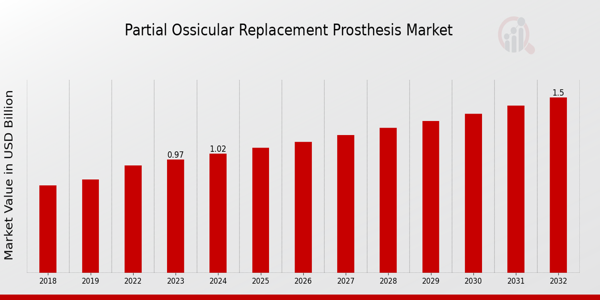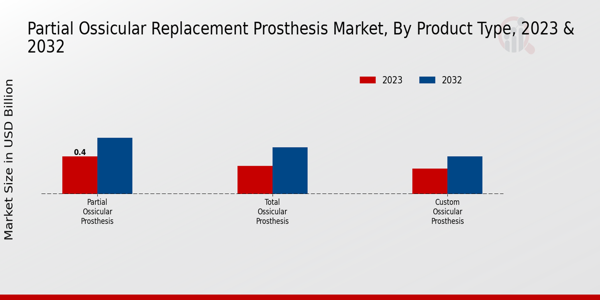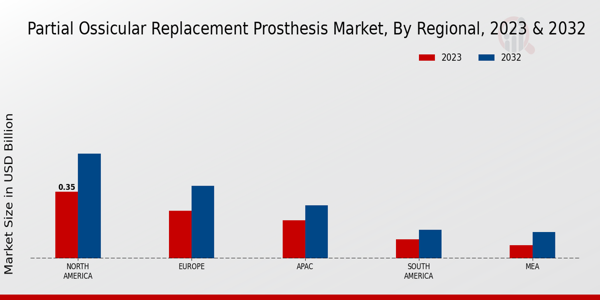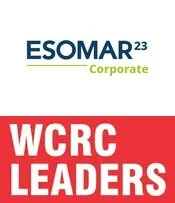Partial Ossicular Replacement Prosthesis Market Overview
As per MRFR analysis, the Partial Ossicular Replacement Prosthesis Market Size was estimated at 1.06 (USD Billion) in 2024. The Partial Ossicular Replacement Prosthesis Market Industry is expected to grow from 1.12 (USD Billion) in 2025 to 1.72 (USD Billion) till 2034, at a CAGR (growth rate) is expected to be around 4.95% during the forecast period (2025 - 2034).
Key Partial Ossicular Replacement Prosthesis Market Trends Highlighted
The Partial Ossicular Replacement Prosthesis Market is experiencing significant growth due to several key market drivers. An increasing prevalence of otosclerosis and chronic ear infections has led to a rise in surgical procedures aimed at restoring hearing. Advances in prosthetic technology are enhancing the effectiveness of these devices, making surgeries more successful and improving patient outcomes. Additionally, an aging population is contributing to higher demand for hearing restoration options as age-related hearing loss becomes more common. Improved awareness and education about hearing-related issues are also leading to more individuals seeking treatment.With the evolution of innovations, the opportunities in the market are endless. The creation of such incompetent invasive surgical procedures can result in faster recovery time and a reduction in hospital admissions, which is of interest to both patients and providers. Further prosthetic fitting to suit individual anatomy can enhance the success rate of the surgery. There is also potential for collaboration between the manufacturers and the healthcare practitioners, which can enhance the research and development of better materials and designs. There is also scope in developing economies where, with better access to healthcare facilities, there can be more demand for solutions for hearing impairment.
Currently, however, the market has been shaped by the developments in the area of patient-centered care, i.e., the trend of developing individualized treatment regimens and enhancing patient quality of life. Telemedicine and remote monitoring are also on the rise, which allows better follow-up and support after the procedure. Sustainability is also getting attention when manufacturers try to shift towards sustainable materials and technologies. These trends speak volumes about the changes taking place in the market and the need for evolution together to the needs of patients and providers of healthcare services. 
Source Primary Research, Secondary Research, MRFR Database and Analyst Review
Partial Ossicular Replacement Prosthesis Market Drivers
Increasing Prevalence of Hearing Loss
The Partial Ossicular Replacement Prosthesis Market is significantly driven by the rising prevalence of hearing loss globally. Factors such as aging populations and increased exposure to noise pollution have led to a higher incidence of auditory disorders that necessitate medical intervention. Hearing loss affects millions globally, prompting a greater demand for effective treatment options, including surgeries that utilize partial ossicular replacement prostheses.These prostheses are designed to restore the function of the middle ear by replacing damaged ossicles, facilitating improved hearing capabilities for patients. Additionally, as awareness regarding hearing health increases and more individuals seek treatment for their auditory issues, there is a corresponding rise in the need for innovative solutions like partial ossicular prostheses. This trend is further supported by advancements in medical technology that have enhanced the effectiveness and reliability of these prostheses, thereby boosting their adoption.Thus, the growing number of hearing loss cases can be identified as a significant market driver for the Partial Ossicular Replacement Prosthesis Market industry, influencing market growth and future prospects by creating a steady demand for surgical interventions that utilize these products.
Technological Advancements in Prosthetic Devices
Technological advancements in prosthetic devices are a key driver for the Partial Ossicular Replacement Prosthesis Market. Innovations in design and materials have led to the development of more effective and biocompatible prostheses, improving surgical outcomes and patient satisfaction. These advancements not only address the limitations of traditional prosthetic options but also enhance the performance of the devices, thereby encouraging more surgical interventions.As manufacturers continue to invest in research and development, the introduction of next-generation prostheses is expected to expand the market significantly.
Rising Awareness and Acceptance of Ear Surgeries
Rising awareness and acceptance of ear surgeries among patients is a significant driver for the Partial Ossicular Replacement Prosthesis Market. Increasing educational initiatives, improved healthcare access, and successful surgical outcomes have contributed to a shift in public perception regarding ear surgeries. As patients become more knowledgeable about the benefits of these procedures, including the restoration of hearing capabilities and quality of life improvements, they are more likely to opt for surgical interventions that involve partial ossicular replacement prostheses.This trend is anticipated to fuel market growth as more individuals seek solutions for their hearing impairments.
Partial Ossicular Replacement Prosthesis Market Segment Insights
Partial Ossicular Replacement Prosthesis Market Product Type Insights
The Partial Ossicular Replacement Prosthesis Market shows a diverse landscape characterized by various product types, which include Partial Ossicular Prosthesis, Total Ossicular Prosthesis, and Custom Ossicular Prosthesis. In 2023, the overall market was valued at 0.97 USD Billion, with every product category playing a crucial role in catering to the needs of patients undergoing innerear procedures. Among these categories, the Partial Ossicular Prosthesis holds a significant portion of the market with a valuation of 0.4 USD Billion. This category is regarded as a major player because it assists in improving sound conduction in cases where only part of the ossicular chain needs reconstruction. In 2032, its valuation is expected to rise to 0.6 USD Billion, showcasing its steady demand driven by increasing hearing loss cases.
Total Ossicular Prosthesis, on the other hand, generated revenues of 0.3 USD Billion in 2023, which highlights its importance for patients who require a complete ossicular reconstruction due to severe conditions. Its growth potential reflects an increasing number of complex ear surgeries, with the projected valuation reaching 0.5 USD Billion by 2032. This segment is significant due to its application in more extensive surgeries where reconstructive measures are imperative for restoring auditory function.
Custom Ossicular Prosthesis, although smaller in its market share with approximately 0.27 USD Billion in 2023, is gaining traction due to its personalized nature. In 2032, it is expected to grow to 0.4 USD Billion. The custom aspect enables physicians to create prostheses tailored specifically to individuals, addressing unique anatomical challenges. This kind of innovation and customization is becoming increasingly critical in achieving optimal outcomes, thus representing a growing opportunity in the market.
The Partial Ossicular Replacement Prosthesis Market demonstrates a significant portion of its revenue stemming from the Partial Ossicular Prosthesis category, indicating its majority holding compared to Total and Custom Ossicular Prostheses. Market growth is primarily driven by rising incidences of ear disorders, advancements in surgical techniques, and innovations in prosthesis design. Challenges include regulatory hurdles and the need for skilled professionals, but opportunities abound in expanding markets and improving product technology to meet evolving healthcare needs. The collaboration across various sectors, such as healthcare and technology, enhances the Partial Ossicular Replacement Prosthesis Market landscape. As this market evolves, it continues to adapt to the demands of a diverse patient population while striving for enhanced auditory rehabilitation solutions.

Source Primary Research, Secondary Research, MRFR Database and Analyst Review
Partial Ossicular Replacement Prosthesis Market Material Insights
The Partial Ossicular Replacement Prosthesis Market, valued at 0.97 USD billion in 2023, showcases a diverse range of materials that contribute to its growth dynamics. Among these materials, Titanium is known for its biocompatibility and strength, making it a preferred choice in many procedures. Silicone is notable for its flexibility and ease of implantation, which enhances patient comfort and outcomes. Hydroxyapatite offers unique advantages due to its ability to promote bone integration, while Polymer materials are increasingly recognized for their light weight and adaptability in various surgical environments.The demand for these materials is driven by rising surgical procedures, advancements in technology, and an increasing aging population, alongside challenges such as varying material costs and regulatory hurdles. The Partial Ossicular Replacement Prosthesis Market segmentation indicates not only the importance of these materials in enhancing surgical efficacy but also their role in driving innovation within the industry. As the market expands, particularly from 2025 to 2034, a significant focus on the development and enhancement of these materials is expected to foster further growth opportunities.
Partial Ossicular Replacement Prosthesis Market End User Insights
The Partial Ossicular Replacement Prosthesis Market is experiencing a robust growth trajectory within the End User segment, primarily driven by Hospitals, Ambulatory Surgical Centers, and Specialty Clinics. In 2023, the overall market was valued at 0.97 billion USD, reflecting the increasing demand for advanced surgical solutions. Hospitals play a crucial role, as they often serve as primary facilities for complex ear surgeries, leading to a significant portion of the market share. Ambulatory Surgical Centers have also gained traction due to their capacity for efficient outpatient procedures, further enhancing patient convenience.Specialty Clinics focusing on ear health are critical for providing targeted care and fostering innovation in prosthetic technologies. As the market evolves, trends such as the rise in ear-related disorders and advancements in prosthesis materials contribute to the growth potential across these end-user categories. Overall, the Partial Ossicular Replacement Prosthesis Market statistics indicate that all these sectors will likely continue to play a vital role in shaping the industry's landscape, presenting both challenges and opportunities in meeting the specialized needs of patients.
Partial Ossicular Replacement Prosthesis Market Surgery Type Insights
The Partial Ossicular Replacement Prosthesis Market, valued at 0.97 billion USD in 2023, has seen a growing demand due to advancements in surgical techniques and technology within the Surgery Type segment. This segment encompasses various approaches, including Open Surgery, Endoscopic Surgery, and Transcanal Surgery. Open Surgery has traditionally been a widely utilized method, offering direct access and the ability to address complex middle ear conditions, contributing significantly to the market's growth. Conversely, Endoscopic Surgery is gaining traction for its minimally invasive nature, reducing patient recovery time and hospital stays, thus appealing to both patients and healthcare providers.Additionally, Transcanal Surgery, although a less common method, is notable for its effectiveness in improving hearing outcomes with minimal anatomical disruption. The increasing prevalence of otological disorders globally acts as a vital growth driver, while evolving surgical methodologies and innovations in prosthesis design present significant opportunities for expansion. Challenges such as the high cost of advanced surgical devices and the need for skilled professionals in newer techniques persist in this rapidly evolving market. Overall, these dynamics play a pivotal role in shaping the future landscape of the Partial Ossicular Replacement Prosthesis Market.
Partial Ossicular Replacement Prosthesis Market Regional Insights
The Partial Ossicular Replacement Prosthesis Market has shown notable growth across its Regional segments, with North America leading the way. This region holds a market value of 0.35 USD Billion in 2023 and is projected to reach 0.55 USD Billion by 2032, showcasing its significant majority holding in the industry. Europe closely follows, with a valuation of 0.25 USD Billion in 2023, anticipated to grow to 0.38 USD Billion, benefiting from advanced healthcare infrastructures and increasing awareness of ear surgeries. The APAC region, valued at 0.20 USD Billion in 2023, is expected to become increasingly important due to rising patient populations and healthcare investments, highlighting its importance in the Partial Ossicular Replacement Prosthesis Market.Meanwhile, South America and MEA, with valuations of 0.10 USD Billion and 0.07 USD Billion, respectively, in 2023, represent emerging markets with potential for growth, though they currently hold smaller shares. The market dynamics indicate that North America's dominance is driven by high demand for advanced medical devices, while Europe capitalizes on innovative surgical solutions. In contrast, APAC emerges as a potential growth frontier, given its expanding healthcare facilities and rising awareness concerning hearing impairments.

Source Primary Research, Secondary Research, MRFR Database and Analyst Review
Partial Ossicular Replacement Prosthesis Market Key Players and Competitive Insights
The Partial Ossicular Replacement Prosthesis Market has been witnessing dynamic changes driven by technological advancements, increasing prevalence of hearing loss, and the growing geriatric population requiring surgical interventions related to the middle ear. Competitive insights reveal a landscape marked by key players innovating in product development, enhancing their market presence through strategic collaborations, and expanding their manufacturing capabilities. The focus on improving patient outcomes, coupled with robust R&D investments, positions companies to effectively cater to the rising demand for such prosthetic solutions. The market is characterized by a mix of established firms and emerging players, leading to competitive pricing and a variety of product offerings, which ultimately benefit healthcare providers and patients alike.Medtronic stands out in the Partial Ossicular Replacement Prosthesis Market with its strong reputation for innovation and reliability. The company’s extensive portfolio of medical devices is bolstered by its commitment to research and development, enabling it to improve the performance and functionality of its ossicular replacement solutions. Medtronic has established a significant market presence through strategic partnerships and distribution channels, ensuring that its products are accessible to a vast network of healthcare professionals. Its emphasis on collaboration with experts in otology and continuous feedback from users has led to the refinement of its technologies. Additionally, Medtronic's focus on providing comprehensive training and support for healthcare practitioners enhances the overall adoption and effectiveness of its offerings, positioning the company as a leader in delivering quality partial ossicular replacement prostheses.Johnson and Johnson have made noteworthy strides in the Partial Ossicular Replacement Prosthesis Market, leveraging its substantial industry experience and expansive distribution network. The company's dedication to enhancing patient care through advanced surgical solutions helps solidify its competitive edge. Johnson and Johnson prioritize innovation, ensuring that their products meet the evolving demands of auditory surgical procedures. The organization’s strong research base allows for the development of effective prosthetic alternatives, catering to a variety of needs within the ear surgery sector. In addition to technological advancements, Johnson and Johnson's global outreach and marketing strategies contribute to their robust brand recognition and trust among healthcare professionals. Their commitment to collaborating with surgeons and providing educational resources further enhances the effective integration of their prosthetic solutions in clinical settings.
Key Companies in the Partial Ossicular Replacement Prosthesis Market Include
- Medtronic
- Johnson and Johnson
- Hearing Life
- Rion
- Smith and Nephew
- Cochlear
- Sonova
- Oticon
- Toshiba
- Earlens
- GN Store Nord
- MEDEL
- WSi
- Stryker
- Amplifon
Partial Ossicular Replacement Prosthesis Market Industry Developments
Recent developments in the Partial Ossicular Replacement Prosthesis Market have shown significant advancements, particularly with notable companies such as Medtronic, Johnson & Johnson, and Cochlear emphasizing innovation in their product offerings. Furthermore, Hearing Life and Oticon are expanding their portfolios to include advanced prosthetic solutions to cater to the evolving needs of patients. In terms of current affairs, there is an increasing focus on research and development investments among key players, which is expected to boost market growth as technological advancements improve patient outcomes. Notably, mergers and acquisitions have been an important aspect, with Smith & Nephew and Sonova reportedly exploring strategic partnerships to enhance their competitive positioning. Additionally, recent financial reports suggest that companies like Amplifon and GN Store Nord have witnessed improved market valuations driven by heightened demand for hearing restoration solutions. These trends reflect a robust landscape in the partial ossicular replacement prosthesis area, highlighting the ongoing commitment of these organizations to advance auditory health technology and enhance consumer access to cutting-edge solutions.
Partial Ossicular Replacement Prosthesis Market Segmentation Insights
Partial Ossicular Replacement Prosthesis Market Product Type Outlook
- Partial Ossicular Prosthesis
- Total Ossicular Prosthesis
- Custom Ossicular Prosthesis
Partial Ossicular Replacement Prosthesis Market Material Outlook
- Titanium
- Silicone
- Hydroxyapatite
- Polymer
Partial Ossicular Replacement Prosthesis Market End User Outlook
- Hospitals
- Ambulatory Surgical Centers
- Specialty Clinics
Partial Ossicular Replacement Prosthesis Market Surgery Type Outlook
- Open Surgery
- Endoscopic Surgery
- Transcanal Surgery
Partial Ossicular Replacement Prosthesis Market Regional Outlook
- North America
- Europe
- South America
- Asia Pacific
- Middle East and Africa
| Report Attribute/Metric |
Details |
|
Market Size 2024
|
1.06 (USD Billion)
|
|
Market Size 2025
|
1.12 (USD Billion)
|
|
Market Size 2034
|
1.72 (USD Billion)
|
|
Compound Annual Growth Rate (CAGR)
|
4.95 % (2025 - 2034)
|
|
Report Coverage
|
Revenue Forecast, Competitive Landscape, Growth Factors, and Trends
|
|
Base Year
|
2024
|
|
Market Forecast Period
|
2025 - 2034
|
|
Historical Data
|
2020 - 2024
|
| Market Forecast Units |
USD Billion |
| Key Companies Profiled |
Medtronic, Johnson and Johnson Hearing Life, Rion, Smith and Nephew, Cochlear, Sonova, Oticon, Toshiba, Earlens, GN Store Nord, MEDEL, WSi, Stryker, Amplifon |
| Segments Covered |
Product Type, Material, End User, Surgery Type, Regional |
| Key Market Opportunities |
Growing geriatric population, Increasing prevalence of hearing loss, Advancements in prosthesis technology, Rising demand for minimally invasive procedures, Expanding healthcare infrastructure in emerging markets |
| Key Market Dynamics |
Increasing prevalence of hearing loss, Technological advancements in prosthesis design, Rising geriatric population, Growing demand for minimally invasive procedures, Expansion of healthcare infrastructure |
| Countries Covered |
North America, Europe, APAC, South America, MEA |
Frequently Asked Questions (FAQ) :
The Partial Ossicular Replacement Prosthesis Market is expected to be valued at 1.5 USD Billion in 2034.
The expected CAGR for the Partial Ossicular Replacement Prosthesis Market from 2025 to 2034 is 4.95%.
North America is projected to hold the largest market share, valued at 0.55 USD Billion in 2032.
The market size for Total Ossicular Prosthesis is expected to reach 0.5 USD Billion in 2034.
Key players in the market include Medtronic, Johnson and Johnson, Cochlear, and Stryker, among others.
The market size for Partial Ossicular Prosthesis is valued at 0.4 USD Billion in 2023 and is expected to reach 0.6 USD Billion in 2034.
The market for Custom Ossicular Prosthesis is projected to grow from 0.27 USD Billion in 2023 to 0.4 USD Billion in 2034.
The market faces challenges such as regulatory hurdles and high costs of advanced prosthetic devices.
The Asia-Pacific region is expected to achieve a market size of 0.28 USD Billion by 2034.
Emerging trends include advancements in materials and technology used in ossicular prostheses.














